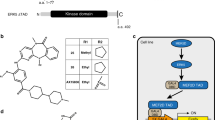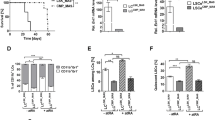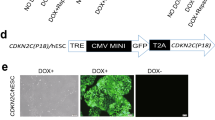Abstract
The Raf/MEK/ERK kinase cascade plays a critical role in transducing growth signals from activated cell surface receptors. Using ΔMEK1:ER, a conditionally active form of MEK1 which responds to either β-estradiol or the estrogen receptor antagonist 4 hydroxy-tamoxifen (4HT), we previously documented the ability of this dual specificity protein kinase to abrogate the cytokine-dependency of human (TF-1) and murine (FDC-P1 and FL5.12) hematopoietic cells lines. Here we demonstrate the ability of ΔMEK1:ER to activate the phosphatidylinositol 3-kinase (PI3K)/Akt/p70 ribosomal S6 kinase (p70S6K) pathway and the importance of this pathway in MEK1-mediated prevention of apoptosis. MEK1-responsive cells can be maintained long term in the presence of β-estradiol, 4HT or IL-3. Removal of hormone led to the rapid cessation of cell proliferation and the induction of apoptosis in a manner similar to cytokine deprivation of the parental cells. Stimulation of ΔMEK1:ER by 4HT resulted in ERK, PI3K, Akt and p70S6K activation. Treatment with PI3K, Akt and p70S6K inhibitors prevented MEK-responsive growth. Furthermore, the apoptotic effects of PI3K/Akt/p70S6K inhibitors could be enhanced by cotreatment with MEK inhibitors. Use of a PI3K inhibitor and a constitutively active form of Akt, [ΔAkt(Myr+)], indicated that activation of PI3K was necessary for MEK1-responsive growth and survival as activation of Akt alone was unable to compensate for the loss of PI3K activity. Cells transduced by MEK or MEK+Akt displayed different sensitivities to signal transduction inhibitors, which targeted these pathways. These results indicate a requirement for the activation of the PI3K pathway during MEK-mediated transformation of certain hematopoietic cells. These experiments provide important clues as to why the identification of mutant signaling pathways may be the Achilles heel of leukemic cell growth. Leukemia treatment targeting multiple signal transduction pathways may be more efficacious than therapy aimed at inhibiting a single pathway.
This is a preview of subscription content, access via your institution
Access options
Subscribe to this journal
Receive 12 print issues and online access
$259.00 per year
only $21.58 per issue
Buy this article
- Purchase on Springer Link
- Instant access to full article PDF
Prices may be subject to local taxes which are calculated during checkout






Similar content being viewed by others
References
Blalock WL, Weinstein-Oppenheimer C, Chang F, Hoyle PE, Wang XY, Algate PA et al. Signal transduction, cell cycle regulatory, and anti-apoptotic pathways regulated by IL-3 in hematopoietic cells: possible sites for intervention with anti-neoplastic drugs. Leukemia 1999; 13: 1109–1166.
Lee JR JT, McCubrey JA . The Raf/MEK/ERK signal transduction cascade as a target for chemotherapeutic intervention in leukemia. Leukemia 2002; 16: 486–507.
Franklin RA, McCubrey JA . Kinases: positive and negative regulators of apoptosis. Leukemia 2000; 14: 2019–2034.
Ruvolo PP . Ceramide regulates cellular homeostasis via diverse signaling pathways. Leukemia 2001; 15: 1153–1160.
Srinivasa SP, Doshi PD . Extracellular signal-regulated kinase and p38 mitogen-activated protein kinase pathways cooperate in mediating cytokine-induced proliferation of a leukemia cell line. Leukemia 2002; 16: 244–253.
Abegg AL, Vickery LE, Bremer ME, Donnelly AM, Doshi PD, Evans ML et al. The enhanced in vitro hematopoietic activity of leridistim, a chimeric dual G-CSF and IL-3 receptor antagonist. Leukemia 2002; 16: 316–326.
Dexter TM, Garland J, Scott D, Scolnick E, Metcalf D . Growth of factor-dependent hematopoietic precursor cell lines. J Exp Med 1982; 152: 1036–1047.
McCubrey JA, Holland G, McKearn J, Risser R . Abrogation of factor-dependence in two IL-3-dependent cell lines can occur by two distinct mechanisms. Oncogene Res 1989; 4: 97–109.
McCubrey JA, Steelman LS, Hoyle PA, Blalock WL, Weinstein-Oppenheimer CR, Franklin RA et al. Differential abilities of activated Raf oncoproteins to abrogate cytokine-dependency, prevent apoptosis and induce autocrine growth factor synthesis in human hematopoietic cells. Leukemia 1998; 12: 1903–1929.
McCubrey JA, Smith SR, Algate PA, de Vente JE, White MK, Steelman LS . Retroviral infection can abrogate the factor-dependency of hematopoietic cells by autocrine and non-autocrine mechanisms depending on the presence of a functional viral oncogene. Oncogene 1993; 8: 2905–2915.
Wang XY, McCubrey JA . Differential effects of retroviral long terminal repeats on interleukin-3 gene expression and autocrine transformation. Leukemia 1997; 11: 1711–1725.
McCubrey JA, Steelman LS, Mayo MW, Algate PA, Dellow RA, Kaleko M . Growth promoting effects of insulin-like growth factor-1 on hematopoietic cells: overexpression of introduced IGF-1 receptor abrogates IL-3-dependency of murine factor dependent cells by a ligand-dependent mechanism. Blood 1991; 78: 921–929.
Algate PA, Steelman LS, Mayo MW, Miyajima A, McCubrey JA . Regulation of the interleukin-3 (IL-3) receptor by IL-3 in the fetal liver-derived FL5.12 cell line. Blood 1994; 83: 2450–2468.
Ihle JN, Witthuhn BA, Quell FW, Yamamoto K, Silvennoinen O . Signaling through the hematopoietic cytokine receptors. Annu Rev Immunol 1995; 13:369–399.
Kinoshita T, Yokota T, Arai K-I, Miyajima A . Suppression of apoptotic death in hematopoietic cells by signaling through the IL-3/GM-CSF receptors. EMBO J 1995; 14: 266–275.
Steelman LS, Algate PA, Blalock WL, Wang XY, Prevost KD, Hoyle PE et al. Oncogenic effects of overexpression of the interleukin-3 receptor on hematopoietic cells. Leukemia 1996; 10: 528–542.
Ruvolo PP, Deng X, May WS . Phosphorylation of Bcl2 and regulation of apoptosis. Leukemia 2001; 15: 515–522.
Pratt JC, Weiss M, Sieff CA, Shoelson SE, Burakoff SJ, Ravichandran KS . Evidence for a physical association between the Shc-PTB domain and the Bc chain of the granulocyte–macrophage colony-stimulating factor receptor. J Biol Chem 1996; 271: 12137–12140.
Corey S, Eguinoa A, Puyana-Theall K, Bolen JB, Cantley L, Mollinedo F et al. Granulocyte–macrophage colony-stimulating factor stimulates both association and activation of phosphoinositide 3OH-kinase and src-related tyrosine kinase(s) in human myeloid derived cells. EMBO J 1993; 12: 2681–2690.
Chang F, Lee JT, Navolanic PM, Steelman JG, Blalock WL, Franklin RA et al. Involvement of PI3K/Akt pathway in cell cycle progression, apoptosis, and neoplastic transformation: a target for cancer chemotherapy. Leukemia 2003; 17: 590–603.
Chang F, Steelman LS, Shelton JG, Lee JT, Navolanic PN, Blalock WL et al. Regulation of cell cycle progression and apoptosis by the Ras/Raf/MEK/ERK pathway. Int J Oncol 2003; 22: 469–481.
Chang F, Steelman LS, Lee JT, Shelton JG, Navolanic PM, Blalock WL et al. Signal transduction mediated by the Ras/Raf/MEK/ERK pathway from cytokine receptors to transcription factors: potential targeting for therapeutic intervention. Leukemia 2003; 17 (in press).
McCubrey JA, May WS, Duronio V, Mufson A . Serine/threonine phosphorylation in cytokine signal transduction. Leukemia 2000; 14: 9–21.
Boer AK, Drayer AL, Vellenga E . Effects of overexpression of the SH2-containing inositol phosphatase SHIP on proliferation and apoptosis of erythroid AS-E2 cells. Leukemia 2001; 15: 1750–1757.
White MK, McCubrey JA . Suppression of apoptosis: role in cell growth and neoplasia. Leukemia 2001; 15: 1011–1021.
Mirza A, Kohn AD, Roth RA, McMahon M . Oncogenic transformation of cells by a conditionally active form of the protein kinase Akt/PKB. Cell Growth Diff 2000; 11: 279–292.
Jucker M, Sudel K, Horn S, Wegner W, Fiedler W, Feldman RA . Expression of a mutated form of the p85alpha regulatory subunit of phosphatidylinositol 3-kinase in a Hodgkin's lymphoma-derived cell line (CO). Leukemia 2002; 16: 894–901.
Abe M, Suzuki K, Inagaki O, Sassa S, Shikama H . A novel MPL point mutation resulting in thrombopoietin-independent activation. Leukemia 2002; 16: 1500–1506.
Jordan CT, Upchurch D, Szilvassy SJ, Guzman ML, Howard DS, Pettigrew AL et al. The interleukin-3 receptor alpha chain is a unique marker for human acute myelogenous leukemia stem cells. Leukemia 2000; 14: 1777–1784.
Shelton JG, Steelman LS, Lee JT, Knapp SL, Blalock WL, Moye PM et al. Effects of the Raf/MEK/ERK and PI3K signal transduction pathways on the abrogation of cytokine dependence and prevention of apoptosis in hematopoietic cells. Oncogene 2003 (in press).
Andreeff M, Jiang S, Zhang X, Konopleva M, Estrov Z, Snell VE et al. Expression of Bcl-2-related genes in normal and AML progenitors: changes induced by chemotherapy and retinoic acid. Leukemia 1999; 13: 1881–1892.
Miranda MB, McGuire TF, Johnson DE . Importance of MEK-1/2 signaling in monocytic and granulocytic differentiation of myeloid cell lines. Leukemia 2002; 16: 683–692.
Shelly C, Petruzzelli L, Herrera R . PMA-induced phenotypic changes in K562 cells: MAPK-dependent and—independent events. Leukemia 1998; 12: 1951–1961.
Dent P, Jarvis WD, Birrer MJ, Fisher PB, Sch-Ullrich RK, Grant S . The roles of signaling by the p42/p44 mitogen-activated protein (MAP) kinase pathway; potential route to radio- and chemo-sensitization of tumor cells resulting in the induction of apoptosis and loss of clonogenicity. Leukemia 1998; 12: 1843–1850.
Ito T, Deng X, Carr B, May WS . Bcl-2 phosphorylation required for anti-apoptosis function. J Biol Chem 1997; 272: 11671–11673.
Deng X, Ito T, Carr B, May WS . Reversible phosphorylation of Bcl2 following interleukin 3 or bryostatin 1 is mediated by direct interaction with protein phosphatase 2A. J Biol Chem 1998; 273: 34157–34163.
Scheid MP, Schubert KM, Duronio V . Regulation of Bad phosphorylation and association with Bcl-XL by the MAPK/Erk kinase. J Biol Chem 1999; 274: 31108–31113.
Blalock WL, Pearce M, Steelman LS, Franklin RA, McCarthy SA, Cherwinski H et al. A conditionally active form of MEK1 abrogates cytokine dependency in human and mouse hematopoietic cells. Oncogene 2000; 19: 526–536.
Blalock WL, Moye PW, Chang F, Pearce M, Steelman LS, McMahon M et al. Combined effects of aberrant MEK1 activity and BCL2 overexpression on relieving the cytokine-dependency of human and murine hematopoietic cells. Leukemia 2000; 14: 1080–1096.
Blalock WL, Pearce M, Chang F, Lee J, Pohnert SC, Burrows C et al. Effects of inducible MEK1 Activation on the cytokine-dependency of lymphoid cells. Leukemia 2001; 15: 794–807.
Davies SP, Reddy H, Caivano M, Cohen P . Specificity and mechanism of action of some commonly used protein kinase inhibitors. Biochem J 2000; 351: 95–105.
Kohn D, Takeuchi F, Roth RA . Akt, a pleckstrin homology domain containing kinase, is activated primarily by phosphorylation. J Biol Chem 1996; 271: 21920–21926.
Auger KR, Serunian LA, Soltoff SP, Libby P, Cantley LC . PDGF-dependent tyrosine phosphorylation stimulates production of novel polyphosphoinositides in intact cells. Cell 1989; 57: 167–175.
Zhang FX, Rubin R, Rooney TA . N-methyl-D-aspartate inhibits apoptosis through activation of phosphatidylinosito 3-kinase in cerebellar granule neurons. A role for insulin receptor substrate-1 in the neurotrophic action of n-D-aspartate and its inhibition by ethanol. J Biol Chem 1998; 273: 26596–25602.
Hoyle PE, Moye PW, Steelman LS, Blalock WL, Franklin RA, Pearce M et al. Differential abilities of the Raf family of protein kinases to abrogate cytokine-dependency and prevent apoptosis in murine hematopoietic cells by a MEK1-dependent mechanism. Leukemia 2000; 14: 642–656.
Johnson DE . Noncaspase proteases in apoptosis. Leukemia 2000; 14: 1695–1703.
Johnson DE . Programmed cell death regulation: basic mechanisms and therapeutic opportunities. Leukemia 2000; 14: 1340–1344.
Antoku K, Liu Z, Johnson DE . IL-3 withdrawal activates a CrmA-insensitive poly (ADP-ribose) polymerase cleavage enzyme in factor-dependent myeloid progenitor cells. Leukemia 1998; 12: 682–689.
Antoku K, Liu Z, Johnson DE . Inhibition of caspase proteases by CrmA enhances the resistance of human leukemic cells to multiple chemotherapeutic agents. Leukemia 1997; 10: 1665–1672.
Boudard D, Sordet O, Vasselon C, Revol V, Bertheas MF, Freyssenet D et al. Expression and activity of caspases 1 and 3 in myelodysplastic syndromes. Leukemia 2000; 14: 2045–2051.
Blagosklonny MV . Cell death beyond apoptosis. Leukemia 2000; 14: 1502–1508.
Harada H, Andersen JS, Mann M, Terada N, Korsmeyer SJ . p70S6 kinase signals cell survival as well as growth, inactivating the pro-apoptotic molecule Bad. Proc Natl Acad Sci USA 2001; 98: 9666–9670.
Zwiebel JA . New agents for acute myelogenous leukemia. Leukemia 2000; 14: 488–490.
Vrana JA, Wang Z, Rao AS, Tang L, Chen JH, Kramer LB et al. Induction of apoptosis and differentiation by fludarabine in human leukemia cells (U937): interactions with the macrocyclic lactone bryostatin 1. Leukemia 1999; 13: 1046–1055.
O'Gorman DM, McKenna SL, McGahon AJ, Knox KA, Cotter TG . Sensitisation of HL60 human leukaemic cells to cytotoxic drug-induced apoptosis by inhibition of PI3K-kinase survival signals. Leukemia 2000; 14: 602–611.
Porosnicu M, Nimmananapalli R, Nguyen D, Worthington E, Perkins C, Bhalla KN . Co-treatment with As203 enhances selective cytotoxic effects of STI-571 against Bcr-Abl positive acute leukemia cells. Leukemia 2001; 15: 772–778.
Damiano JS, Hazlehurst LA, Dalton WS . Cell adhesion-mediated drug resistance (CAM-DR) protects the K562 chronic myelogenous leukemia cell line from apoptosis induced by BCR/ABL inhibition, cytotoxic drugs, and gamma-irradiation. Leukemia 2001; 15: 1232–1239.
Zhao M, Kiyoi H, Yamamoto Y, Ito M, Towatari M, Omura S et al. In vivo treatment of mutant FLT3-transformed murine leukemia with a tyrosine kinase inhibitor. Leukemia 2000; 14: 374–378.
Tse KF, Novelli E, Civin CI, Bohmer FD, Small D . Inhibition of FLT-3 mediated transformation by use of a tyrosine kinase inhibitor. Leukemia 2001; 15: 1001–1010.
Teller S, Kramer D, Bohmer SA, Tse KF, Small D, Mahboobi S et al. Bis(1H-2-indolyl)-1-methanones as inhibitors of the hematopoietic tyrosine kinase Flt3. Leukemia 2002; 16: 1528–1534.
Minami Y, Kiyoi H, Yamamoto Y, Yamamoto K, Ueda R, Saito H et al. Selective apoptosis of tandemly duplicated FLT3-transformed leukemia cells by Hsp90 inhibitors. Leukemia 2002; 16: 1536–1540.
Acknowledgements
We thank Ms Catherine Spruill for the excellent artwork. This work was supported by grants from the United States National Institutes of Health (R01CA51025) and grants from the North Carolina Biotechnology Center (9805-ARG-0006, 2000-ARG-0003) to JAM. RAF was supported in part by grants from the American Cancer Society (IRG-97-149), American Heart Association (9930099N) and the North Carolina Biotechnology Center (9705-ARG-0009). MKW was supported in part by Public Health Services Grants DK45718 from the National Institutes of Health.
Author information
Authors and Affiliations
Rights and permissions
About this article
Cite this article
Blalock, W., Navolanic, P., Steelman, L. et al. Requirement for the PI3K/Akt pathway in MEK1-mediated growth and prevention of apoptosis: identification of an Achilles heel in leukemia. Leukemia 17, 1058–1067 (2003). https://doi.org/10.1038/sj.leu.2402925
Received:
Accepted:
Published:
Issue Date:
DOI: https://doi.org/10.1038/sj.leu.2402925
Keywords
This article is cited by
-
Oncogenic signaling of class I PI3K isoforms
Oncogene (2008)
-
Contributions of the Raf/MEK/ERK, PI3K/PTEN/Akt/mTOR and Jak/STAT pathways to leukemia
Leukemia (2008)
-
Targeting survival cascades induced by activation of Ras/Raf/MEK/ERK, PI3K/PTEN/Akt/mTOR and Jak/STAT pathways for effective leukemia therapy
Leukemia (2008)
-
Signal transduction pathways that contribute to myeloid differentiation
Leukemia (2007)
-
Arsenic trioxide (ATO) and MEK1 inhibition synergize to induce apoptosis in acute promyelocytic leukemia cells
Leukemia (2005)



